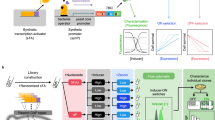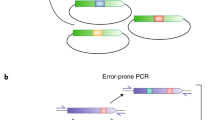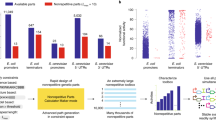Abstract
We have developed a method in which randomized libraries of zinc finger–containing artificial transcription factors are used to induce phenotypic variations in yeast and mammalian cells. By linking multiple zinc-finger domains together, we constructed more than 100,000 zinc-finger proteins with diverse DNA-binding specificities and fused each of them to either a transcription activation or repression domain. The resulting transcriptional regulatory proteins were expressed individually in cells, and the transfected cells were screened for various phenotypic changes, such as drug resistance, thermotolerance or osmotolerance in yeast, and differentiation in mammalian cells. Genes associated with the selected phenotypes were also identified. Our results show that randomized libraries of artificial transcription factors are useful tools for functional genomics and phenotypic engineering.
This is a preview of subscription content, access via your institution
Access options
Subscribe to this journal
Receive 12 print issues and online access
$209.00 per year
only $17.42 per issue
Buy this article
- Purchase on Springer Link
- Instant access to full article PDF
Prices may be subject to local taxes which are calculated during checkout





Similar content being viewed by others
References
Pavletich, N.P. & Pabo, C.O. Zinc finger-DNA recognition: crystal structure of a Zif268-DNA complex at 2.1Å. Science 252, 809–817 (1991).
Wolfe, S.A., Kekludova, L. & Pabo, C.O. DNA recognition by Cys2His2 zinc finger proteins. Annu. Rev. Biophys. Biomol. Struct. 29, 183–212 (2000).
Lee, D.K., Seol, W. & Kim, J.-S. Custom DNA-binding proteins and artificial transcription factors. Curr. Top. Med. Chem. 3, 645–657 (2003).
Rebar, E.J. & Pabo, C.O. Zinc finger phage: affinity selection of fingers with new DNA-binding specificities. Science 263, 671–673 (1994).
Jamieson, A.C., Kim, S.H. & Wells, J.A. In vitro selection of zinc fingers with altered DNA-binding specificity. Biochemistry 33, 5689–5695 (1994).
Choo, Y. & Klug, A. Toward a code for the interactions of zinc fingers with DNA: selection of randomized fingers displayed on phage. Proc. Natl. Acad. Sci. USA 91, 11163–11167 (1994).
Wu, H., Yang, W.P. & Barbas, C.F. III. Building zinc fingers by selection: toward a therapeutic application. Proc. Natl. Acad. Sci. USA 92, 344–348 (1995).
Greisman, H.A. & Pabo, C.O. A general strategy for selecting high-affinity zinc finger proteins for diverse DNA target sites. Science 275, 657–661 (1997).
Desjarlais, J.R. & Berg, J.M. Redesigning the DNA-binding specificity of a zinc finger protein: a data base-guided approach. Proteins. Struct. Funct. Genet. 12, 101–104 (1992).
Nardelli, J., Gibson, T. & Charnay, P. Zinc finger-DNA recognition: analysis of base specificity by site-directed mutagenesis. Nucl. Acids Res. 20, 4137–4144 (1992).
Taylor, W.E. et al. Designing zinc-finger ADR1 mutants with altered specificity of DNA binding to T in UAS1 sequences. Biochemistry 34, 3222–3230 (1995).
Kim, J.-S. & Pabo, C.O. Transcriptional repression by zinc finger peptides: exploring the potential for applications in gene therapy. J. Biol. Chem. 272, 29795–29800 (1997).
Kang, J.S. & Kim, J.-S. Zinc finger proteins as designer transcription factors. J. Biol. Chem. 275, 8742–8748 (2000).
Bae, K.H. et al. Human zinc fingers as building blocks in the construction of artificial transcription factors. Nat. Biotechnol. 21, 275–280 (2003).
Gogos, J.A., Jin, J., Wan, H., Kokkinidis, M. & Kafatos, F.C. Recognition of diverse sequences by class I zinc fingers: asymmetries and indirect effects on specificity in the interaction between CF2II and A+T-rich elements. Proc. Natl. Acad. Sci. USA 93, 2159–2164 (1996).
Hsu, T., Gogos, J.A., Kirsh, S.A. & Kafatos, F.C. Multiple zinc finger forms resulting from developmentally regulated alternative splicing of a transcription factor gene. Science 257, 1946–1950 (1992).
Segal, D.J., Dreier, B., Beerli, R.R. & Barbas, C.F. III. Toward controlling gene expression at will: selection and design of zinc finger domains recognizing each of the 5′-GNN-3′ DNA target sequences. Proc. Natl. Acad. Sci. USA 96, 2758–2763 (1999).
Dreier, B., Beerli, R.R., Segal, D.J., Flippin, J.D. & Barbas, C.F. III. Development of zinc finger domains for recognition of the 5′-ANN-3′ family of DNA sequences and their use in the construction of artificial transcription factors. J. Biol. Chem. 276, 29466–29478 (2001).
Zhang, L. et al. Synthetic zinc finger transcription factor action at an endogenous chromosomal site. Activation of the human erythropoietin gene. J. Biol. Chem. 275, 33850–33860 (2000).
Liu, P.Q. et al. Regulation of an endogenous locus using a panel of designed zinc finger proteins targeted to accessible chromatin regions. J. Biol. Chem. 276, 11323–11334 (2001).
Lee, J.H., Van Montagu, M. & Verbruggen, N. A highly conserved kinase is an essential component for stress tolerance in yeast and plant cells. Proc. Natl. Acad. Sci. USA 96, 5873–5877 (1999).
Vanden Bossche, H. et al. Antifungal drug resistance in pathogenic fungi. Med. Mycol. 36, 119–128 (1998).
Kadosh, D. & Struhl, K. Repression by Ume6 involves recruitment of a complex containing Sin3 corepressor and Rpd3 histone deacetylase to target promoters. Cell 89, 365–371 (1997).
Mendez-Vidal, C., Wilhelm, M.T., Hellborg, F., Qian, W. & Wiman, K.G. The p53-induced mouse zinc finger protein wig-1 binds double-stranded RNA with high affinity. Nucl. Acids Res. 30, 1991–1996 (2002).
Morii, E., Oboli, K., Kataoka, T.R., Iagarashi, K. & Kitamura, Y. Interaction and cooperation of mi transcription factor (MITF) and myc-associated zinc-finger protein-related factor (MAZR) for transcription of mouse mast cell protease 6 gene. J. Biol. Chem. 277, 8566–8571 (2002).
Sanglard, D. et al. Mechanisms of resistance to azole antifungal agents in Candida albicans isolates from AIDS patients involve specific multidrug transporters. Antimicrob. Agents Chemother. 39, 2378–2386 (1998).
Moore, P.A., Ruben, S.M. & Rosen, C.A. Conservation of transcriptional activation functions of the NF-kappa B p50 and p65 subunits in mammalian cells and Saccharomyces cerevisiae. Mol. Cell Biol. 13, 1666–1674 (1993).
Witzgall, R., O'Leary, E., Leaf, A., Onaldi, D. & Bonventre, J.V. The Kruppel-associated box-A (KRAB-A) domain of zinc finger proteins mediates transcriptional repression. Proc. Natl. Acad. Sci. USA 91, 4514–4518 (1994).
Beerli, R.R., Segal, D.J., Drier, B. & Barbas, C.F. III Toward controlling gene expression at will: specific regulation of the erbB-2/HER-2 promoter by using polydactyl zinc finger proteins constructed from modular building blocks. Proc. Natl. Acad. Sci. USA 95, 14628–14633 (1998).
Wainwright, L.J., Lasorella, A. & Lavarone, A. Distinct mechanisms of cell cycle arrest control the decision between differentiation and senescence in human neuroblastoma cells. Proc. Natl. Acad. Sci. USA 98, 9396–9400 (2001).
Katagiri, T. et al. Bone morphogenic protein-2 converts the differentiation pathway of C2C12 myoblasts into the osteoblast lineage. J. Cell. Biol. 127, 1755–1766 (1994).
Campling, B.G., Pym, J., Galbraith, P.R. & Cole, S.P. Use of the MTT assay for rapid determination of chemosensitivity of human leukemic blast cells. Leuk. Res. 12, 823–831 (1988).
Mayer, T.U. et al. Small molecule inhibitor of mitotic spindle bipolarity identified in a phenotype-based screen. Science 286, 971–974 (1999).
De Backer, M.D. et al. An antisense-based functional genomics approach for identification of genes critical for growth of Candida albicans. Nat. Biotechnol. 19, 235–241 (2001).
Welch, P.J. et al. Identification and validation of a gene involved in anchorage-independent cell growth control using a library of randomized hairpin ribozymes. Genomics 66, 274–283 (2000).
Kruger, M. et al. Identification of eIF2Bgamma and eIF2gamma as cofactors of hepatitis C virus internal ribosome entry site-mediated translation using a functional genomics approach. Proc. Natl. Acad. Sci. USA 97, 8566–8571 (2000).
Pierce, M.L. & Ruffner, D.E. Construction of a directed hammerhead ribozyme library; toward the identification of optimal target sites for antisense-mediated gene inhibition. Nucl. Acids Res. 26, 5093–5101 (1998).
Ashrafi, K. et al. Genome-wide RNAi analysis of Caenorhabditis elegans fat regulatory genes. Nature 421, 268–272 (2003).
Stege, J.T., Guan, X., Ho, T., Beachy, R.N. & Barbas, C.F. III. Controlling gene expression in plants using synthetic zinc finger transcription factors. Plant J. 32, 1077–1086 (2002).
Sanches, J.P., Ullman, C., Moore, M., Choo, Y. & Chua, N.H. Regulation of gene expression in Arabidopsis thaliana by artificial zinc finger chimeras. Plant Cell Physiol. 43, 1465–1472 (2002).
Joung, J.K., Ramm, E.I. & Pabo, C.O. A bacterial two-hybrid selection system for studying protein-DNA and protein-protein interactions. Proc. Natl. Acad. Sci. USA 97, 7382–7387 (2000).
Gordon, C.L. et al. Glucoamylase: green fluorescent protein fusions to monitor protein secretion in Aspergillus niger. Microbiology 146, 415–426 (2000).
Blancafort, P., Magnenat, L. & Barbas, C.F. III. Scanning the human genome with combinatorial transcription factor libraries. Nat. Biotechnol. 21, 269–274 (2003).
Tupler, R., Perini, G. & Green, M.R. Expressing the human genome. Nature 409, 832–833 (2001).
Acknowledgements
We thank K.H. Bae, H.C. Shin and J.W. Park for helpful discussions. We also thank Hyun-Mo Ryoo for providing materials, Jae-Ran Lee and Eunjoon Kim for help with immunofluorescence microscopy and K. LaMarco for carefully reading our manuscript. This work was partially supported by the National Research Laboratory Program (M1-0104-00-0048) and by the 21C Frontier Microbial Genomics and Applications Program (MG02-0302-007-2-1-0) of the Korean Ministry of Science and Technology.
Author information
Authors and Affiliations
Corresponding author
Ethics declarations
Competing interests
The research described in the paper was partially funded by ToolGen, Inc., a privately-held company, and most of the authors are employees. J.-S.K. was one of the founders of the company and is a major shareholder.
Rights and permissions
About this article
Cite this article
Park, KS., Lee, Dk., Lee, H. et al. Phenotypic alteration of eukaryotic cells using randomized libraries of artificial transcription factors. Nat Biotechnol 21, 1208–1214 (2003). https://doi.org/10.1038/nbt868
Received:
Accepted:
Published:
Issue Date:
DOI: https://doi.org/10.1038/nbt868
This article is cited by
-
Transcription factor stoichiometry in cell fate determination
Journal of Genetics (2021)
-
Use of fusion transcription factors to reprogram cellulase transcription and enable efficient cellulase production in Trichoderma reesei
Biotechnology for Biofuels (2019)
-
Synthetic biology for evolutionary engineering: from perturbation of genotype to acquisition of desired phenotype
Biotechnology for Biofuels (2019)
-
Synthetic evolution
Nature Biotechnology (2019)
-
Improved xylose tolerance and 2,3-butanediol production of Klebsiella pneumoniae by directed evolution of rpoD and the mechanisms revealed by transcriptomics
Biotechnology for Biofuels (2018)



